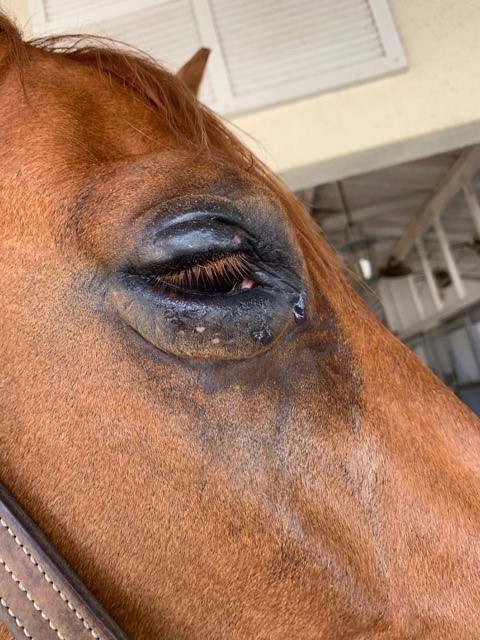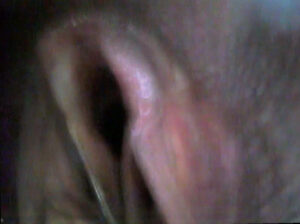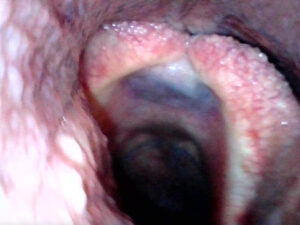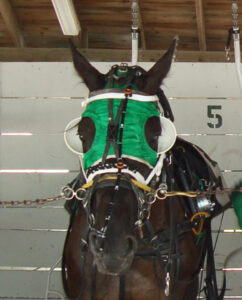Tag: respiratory

Got allergies? Well, chances are, your horses do, too.
With warmer temperatures and spring blooms pushing up pollen levels, it seems like everyone at the barn – human and animal – is coughing and congested. If you have ever wondered what you can do to help a horse suffering from allergies, Palm Beach Equine Clinic veterinarian Dr. David Priest shares his knowledge on addressing allergies and helping horses breathe easy. In his daily veterinary work, Dr. Priest primarily focuses on equine respiratory health. He is experienced in treating conditions ranging from concerning coughs to obstructive or mechanical issues affecting airway function, such as recurrent laryngeal neuropathy (commonly known as “roaring”).
Types and Triggers of Equine Allergies
An allergy is an immune system response to a typically harmless substance, called an allergen. Allergic reactions can range from mild, gradual annoyances to sudden and severe. Generally, allergies manifest two ways in horses; in the respiratory tract or as topical skin allergies.
2. Respiratory Allergies
Respiratory allergies are somewhat similar to asthma in humans and are most commonly referred to as inflammatory airway disease. These respiratory allergies are most often caused by environmental allergens, such as dust, mold, and pollen. Nasal discharge, tearing eyes, and coughing can also be linked to respiratory allergies.
An increase in respiratory rate or an increase in respiratory effort – such as labored breathing or exercise intolerance – are two classic signs. Also, when a horse has a thick mucus-like discharge from its nasal passages, it is concerning to veterinarians as it could indicate an infectious type of respiratory illness. A veterinarian can distinguish whether the culprit is an allergen or if there is an underlying mechanical cause of the respiratory issue. Additionally, horses that experience a dramatic change in their environment may be affected. For example, those traveling from New York to Florida may suffer from completely different allergens such as tree pollens or smoke caused by the burning of sugarcane fields.
2. Skin Reactions
Allergies affecting the skin commonly appear as hives, dermatitis, or hair loss. The administration of topical products as well as a change in the type of stall bedding can trigger such reactions. Topical skin reactions can occur in a specific area or cover the horse’s entire body. Allergies to the common bacteria Dermatophilosis can occur resulting in a painful skin condition. Oftentimes, antifungal or bacterial shampoos can help alleviate this reaction. Consulting your veterinarian is key to determining if your horse suffers from allergies that may undermine your horse’s health or future.
The same allergens that cause respiratory symptoms can also cause skin reactions, but veterinarians tend to approach treatments differently for the two types of reactions.



Pictures: Upon arriving in Florida, this horse was hit with a allergic reaction causing hives all over its body accompanied by severe itching. The patient was initially treated with tripelennamine (injectable antihistamine) and dexamethasone, and then prescribed oral antihistamines and given an allergy and skin supplement to allow the horse to more comfortably adjust to its new environment.
Diagnosing Equine Allergies
Like most conditions, your veterinarian will start by getting a history of the problem, when it first appeared, and any changes that may have occurred recently in the horse’s diet or environment. They will follow with a physical examination, noting the site or region of the horse’s body where there is a flare up. Specific tests such as a biopsy and culture can be performed to rule out other skin conditions or causes – parasites, bacteria, or tumors. A bronchoalveolar lavage (BAL) or a tracheal wash where the veterinarian collects respiratory secretions and then performs a cytology of that fluid can determine if there are abnormalities or specific types of bacteria causing an infection. Serum (blood) allergy testing or imaging, such as an ultrasound of their chest, may be utilized to assess airway health and function and determine if the cause is allergy related.
Treatment and Taking Action Against Allergens
As in a visit to the human allergist, horses can undergo intradermal (skin) allergy testing to pinpoint the source of a horse’s reaction. For this procedure, the horse has a large patch of hair clipped down on their neck so that tiny amounts of various allergens can be injected into a grid pattern. The veterinarian will examine this grid during different time intervals for signs of an allergic response and determine if a targeted treatment can be taken against those specific allergens.


Photos: A PBEC patient with a swollen, tearing eye aggravated by itching, and its improvement after treatment with prescribed Neo-Poly-Bac-HC (eye medication), flunixin meglumine (Banamine), and protection by a fly mask.
Once the veterinarian determines your horse is suffering from allergies and not another condition, the first thing you can do is try to identify and eliminate the allergen. Figuring out what may have been associated with the onset of the allergic reaction is an inexpensive solution, and often the most effective approach.
From a stable-wide perspective, the most important thing you can do is try to minimize dust and flies, two of the most common allergens. While horses are not generally allergic to flies, some can be allergic to fly bites or specific fly species. Insect bites also increase the horse’s stress level, which can further contribute to the immune system’s response. While eliminating insects and environmental allergens is impossible, there are several tactics barn managers can take to mitigate both problems.
A good manure disposal system can cut the population of insects in the barn, as will a reduction in any standing water, especially in the springtime when flies and mosquitoes start to reemerge. Owners can protect their horse from insects by using fly sprays, masks, sheets, and boots, and keeping horses inside during times of the days when bugs are most active. Dust- and pollen-related allergic reactions tend to occur when horses are in the barn because it is a closed-air environment. Dust control tactics, such as wetting hay and shavings, keeping barn aisles clean and swept, and managing fresh airflow in the barn with fans and open doors and windows all contribute to better airflow.
Veterinary treatment is the next line of defense in treating allergies. For acute reactions, some horses benefit from short-term treatment with corticosteroids or antihistamines. Those treatments, however, can have side effects and are prescribed when other interventions, such as modifying the environment to reduce the allergen, are ineffective. Immunomodulatory therapy (allergy shots) is another option that may be effective and can be discussed with your veterinarian.
Knowing how to identify allergies affecting your horse and taking steps to eliminate the allergens will lead to easier breathing and happier horses in your stable. For more information, contact Dr. David Priest at Palm Beach Equine Clinic by calling 561-793-1599.
Dr. David Priest Utilizes Dynamic Endoscope and Performs Surgery to Help Four-Year-Old Harness Racer Get Back in Action
For equine athletes to perform their best, optimal respiratory health is crucial, and particularly paramount for harness racehorses. According to Dr. David Priest, Palm Beach Equine Clinic veterinarian with a keen interest in respiratory health, a racehorse moves roughly 70 liters of air through its lungs over the duration of one second while exercising. To simulate the movement of that amount of air outside the anatomy of a horse’s body, it would require two industrial ShopVacs on full power.
A colloquial condition known as “roaring”, or recurrent laryngeal neuropathy, is a fairly common issue among horses, and it restricts the amount of air able to reach the lungs through the horse’s upper respiratory system. The condition usually affects the left side of the larynx – the equine left recurrent laryngeal nerve is longer than the right – with paralysis that does not allow for an adequate amount of air to travel to the lungs.
According to Dr. Priest, equine anatomy plays a factor in the prevalence of this condition. There is a correlation with the length and size of the neck to the nerve pathways that travel from the brain to the chest, around the heart, and back up to the throat. Although mild cases of recurrent laryngeal neuropathy can be tolerated, the condition becomes particularly serious when a horse’s work involves high-intensity aerobic exercise.
“We often see recurrent laryngeal neuropathy described as a paralyzed flapper,” said Dr. Priest. “If you imagine the flaps of the larynx as cabinet doors, then the horse should be able to hold the doors open without problem while at rest. Yet, when the airflow picks up during exercise, that muscle is sometimes not strong enough to hold the doors open, and it collapses into the airway.”
Just before the start of 2019, Dr. Priest received a call from Stephanie Reames, the trainer of a four-year-old harness racehorse with symptoms pointing to recurrent laryngeal neuropathy. During his diagnostic process, Dr. Priest performed an endoscopy while the horse was resting to provide a baseline observation.
“I saw what I thought was a minor abnormality, but I did not know what amount of laryngeal strength this horse had,” said Dr. Priest. “The roaring noise usually occurs when the disease is progressive, and this horse was making a little bit of noise.


“This particular horse was in training for the harness racing season, so the owners and trainer wanted to figure out the root of the issue as swiftly as possible,” continued Dr. Priest. “The most effective way to accomplish that is to utilize a dynamic endoscope.”
A dynamic endoscope is a video recording device worn by the horse during exercise. It allows veterinarians to see the larynx, and therefore view signs of recurrent laryngeal neuropathy in real-time. Dr. Priest observed the disease as a grade C on the universal grading system for rating the disease, which translates to a full collapse of the left larynx flap.
Once diagnosed, Dr. Priest recommended an aptly-named laryngeal tie-back surgery, which involves stitching the larynx flap to surrounding cartilage in order to hold it open for optimal airflow. He performed the surgery at Palm Beach Equine Clinic a couple of days after making the diagnosis, and the horse returned home to its training base at South Florida Training Center in Lake Worth, FL, the same day.


The suggested recovery time is 30 days to allow for the surgical incisions to heal. Once healed, this horse immediately returned to full harness racing training.
“The horse is doing fantastic and we are hoping to qualify for racing in the next three weeks, and we will most likely head north to Pennsylvania to race,” said Reames. “Dr. Priest is absolutely amazing and was extremely professional from start to finish. There is always a hesitation when you learn that a horse needs surgery, but Dr. Priest was so prompt with the diagnosis and procedure, and the horse healed so quickly. We have high hopes for another successful racing season!”
In February of 2020, Dr. Priest performed a second dynamic endoscopy to observe the condition and effectiveness of the tie-back surgery. “The disease usually results in a 20-30% reduction in airflow, which causes a small performance decline resulting in a speed reduction of maybe one second. This horse’s particular case was perfect at the one-year check, which is key because that one second can be the difference between winning and losing!”
